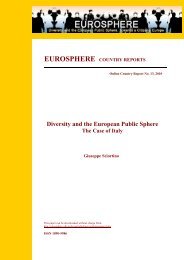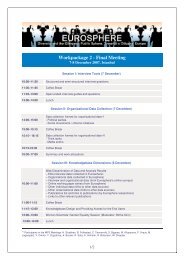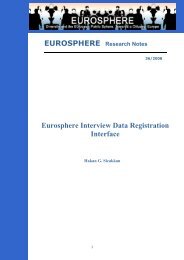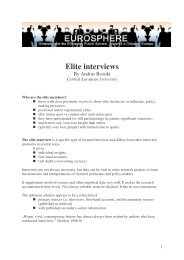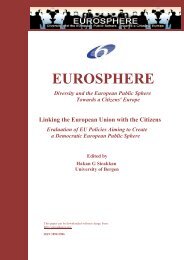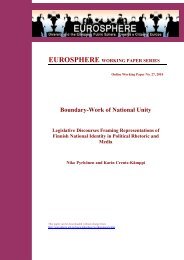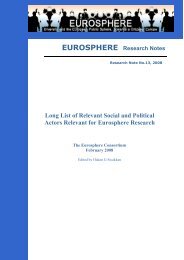Migrants, Minorities, Belongings and Citizenship. Glocalization and ...
Migrants, Minorities, Belongings and Citizenship. Glocalization and ...
Migrants, Minorities, Belongings and Citizenship. Glocalization and ...
You also want an ePaper? Increase the reach of your titles
YUMPU automatically turns print PDFs into web optimized ePapers that Google loves.
1. Variable Principal Normalization used.<br />
2. All dimensions with an eigenvalue over 1 included.<br />
3. Ranking dicretization used.<br />
4. Total variance accounted for 82,23% (rounded).<br />
Each of the 5 dimensions illustrated in the columns of Table 6 shows a particular<br />
multidimensional belonging model that the data set comprises. The variable loadings that<br />
characterize a dimension the most have been marked with different colors. It is possible<br />
to interpret the CATPCA-results from different angles. For the purposes of this report, I<br />
will first briefly give my suggestion of what each dimension means <strong>and</strong> then shortly<br />
comment on how respondents’ degree of European belonging relates to other singular<br />
types of belonging in each dimension. It is important to remember again that these<br />
results relate to the attendants of glocal spaces <strong>and</strong> are not representative of the<br />
belonging profiles of countries’ populations.<br />
Dimension 1: Individualist-national versus subnational/supranational belonging<br />
The respondents who score high on the first dimension are interpreted as identifying<br />
themselves most with their own individual belongings <strong>and</strong> their territorial nation-states.<br />
They relate themselves to the world as not only individual men <strong>and</strong> women, but also as<br />
members of their nations <strong>and</strong> of the humanity (cf. global belonging loads with 0,597 on<br />
dimension-1). Examining these respondents’ statements during qualitative interviews,<br />
one may state that this type of multidimensional belonging represents a pragmatic <strong>and</strong><br />
non-ethnicist approach to the nation-state as the protector of the modern individual<br />
freedom. Thus, they do not conceive of national belonging as something that divides<br />
humanity but as a non-collectivist instrument for the achievement of individual goals. On<br />
the other h<strong>and</strong>, respondents scoring low on this dimension are interpreted as identifying<br />
themselves as members of their subnational ethnic groups, political groups, <strong>and</strong> of<br />
Europe – i.e. a multicultural Europe based on collective ethnic cultures rather than on<br />
national, religious, or global belongings. Global, individual, national, religious,<br />
transnational belongings play little role in their belonging profile. This dimension accounts<br />
for 26% of the total variance.<br />
Dimension 2: Collectivist-transnational versus glocal belonging<br />
The respondents who score high on this dimension identify themselves most with<br />
collective references of belonging – such as religion, ethnicity, <strong>and</strong> nation. They relate<br />
themselves to the world through both their national-territorial <strong>and</strong> subnational<br />
belongings, herein primarily as members of their ethnic groups. Although subnational<br />
ethnic <strong>and</strong> religious belongings seem to be the main ingredients of their profile, they<br />
69



